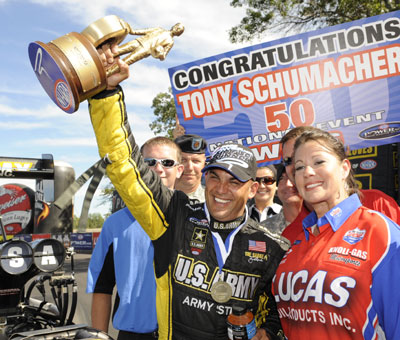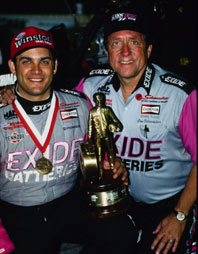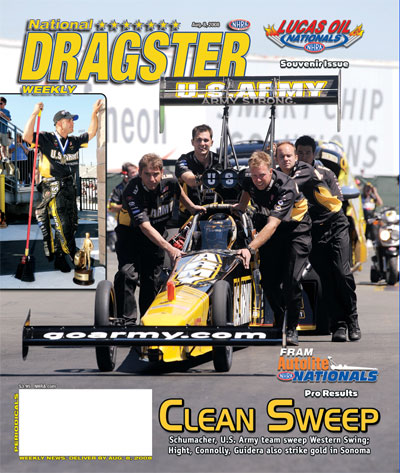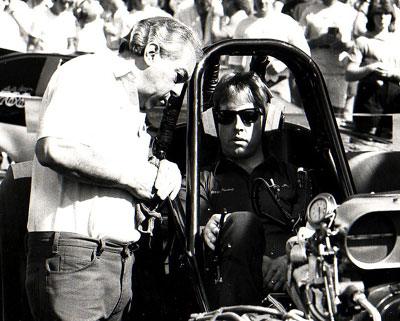

If the Shoe fits ...
 |
Even as our Favorite Race Car Ever poll heads toward the final rounds, I’m still getting e-mails asking how I could possibly have forgotten to include this particular car or that car in the polls. The perceived slights run the gamut from obscure cars that even I haven’t heard of to some more famous cars that actually impacted the sport in different ways, and my answer is always the same: It’s not a best-ever poll or even most-important poll; it’s a poll of favorites submitted by the readers of this column. This was never intended to be a poll proclaiming the best anything, except maybe best-liked or best-remembered.
I’m brought to this point not by the derision of a few – I rather enjoy the exchange of opinions – but simply by the contemplation of what intangible makes up a favorite car in the minds of many. For many, it’s youthful memories, paint schemes, and body design, and, although a car’s “kickassedness” also is a factor (i.e., Don Prudhomme’s Army Monza), it’s not the overwhelming factor. How else do you explain “Jungle Jim” Liberman’s Vega – which won just one national event and never was a championship contender – whipping Raymond Beadle’s Blue Max and “Snake’s” Monza, both of which won multiple world titles and handfuls of events?
You’ll notice, too, that in the 1980s and beyond poll above, there isn’t a single car from the current decade, a nod in part, no doubt, to the sameness of the cars and their being limited largely to national event competition, but I wonder how this same poll would change if it were held 10 or 20 years from now. Specifically, how will Tony Schumacher’s U.S. Army dragster be remembered?
It’s undoubtedly the killer car of this year and arguably of this decade, at least from mid-2003 on. In case you missed it, Schumacher won his 50th Top Fuel title last weekend in Brainerd, bringing him to within two victories of tying Joe Amato as the sport’s winningest nitro-rail driver, a prestigious mantle that Amato has held for nearly 12 years since passing Don Garlits’ 35-win total at the 1996 Finals.
I’ve asked this question a lot, of racers and fans alike, and always received the same answer, and it seems to be indisputable that no matter the number of wins, no driver but Garlits will ever be declared as the sport’s all-time greatest Top Fuel racer. That’s certainly no knock on “Joltin’ Joe” or “the Machine” but rather a bow to Garlits’ did-it-all-myself method of racing. He built the cars, he wrenched on them, he tuned them, and he drove them. It's doubtful that Amato or Schumacher ever even briefly did more than two of those, but don’t blame them. Garlits did it in a different era; back then, that was the way you raced.
Amato didn’t have to get his hands dirty, nor did he try to be Mr. Everything; he was a millionaire businessman racer smart enough to hire very talented people like Al Swindahl and Tim Richards to do those things for him while he sought sponsors and drove a race car about as well as one could drive it. With the responsibilities that befall a guy with a huge and visible sponsor like the U.S. Army, not to mention public-relations duties for them and NHRA, Schumacher also is best left doing what he does: Driving and saluting our troops. It would be silly to see him bust a knuckle between rounds.
Still, I’m going to agree with the popular thought these days that while Schumacher may never be proclaimed the best Top Fuel racer or even driver (there is a difference), his team may certainly be the best Top Fuel team ever assembled. Sure, Garlits had Herb Parks and T.C. Lemmons and Amato had “the General,” Jeff Rodgers, and the Walsh brothers, but from stem to stern, the Army team seems flawless. The sponsor and operation are top notch, the crewmembers put the engine back together flawlessly, crew chief Alan Johnson seldom misses a tuning call, and Schumacher is one of the steadiest drivers out there.
 |
 |
|
Okay, Schumacher fans, time to haul out those old pre-crew-cut photos of "the Sarge" -- (left) as a fresh-faced Top Alcohol Funny Car rookie in 1995 and (right) enjoying his first Top Fuel win in Dallas in 1999 with father Don. |
|
In retrospect, it’s pretty surprising that Schumacher is the guy we’re talking about to be crowned the new king of Top Fuel wins. People forget that Schumacher suffered an almost John Force-like victory drought to begin his career, finishing as runner-up in his first eight finals before finally reaching the winner’s circle at the 1999 Dallas event, where he defeated Scott Kalitta to win his first title. Interestingly, Schumacher spotted Amato exactly 50 victories before he won his first and, truthfully, has done the majority of his winning in the last five years, since hiring Johnson in mid-2003, when he has amassed 43 of his 50 wins. With seasons like his 10-win campaign of 2004 and nine victories in 2005, it’s no surprise that Schumacher collected 50 wins in 37 fewer races than it took Amato (260 to 297).
Oddly, Schumacher has won 47 of his 50 Wallys after Amato unexpectedly retired at the end of the 2000 season, one year short of his planned retirement, due to problems with his eyes, much in the same way that Amato scored the lion’s share of his Top Fuel wins – 45 out of 52 – in a Garlits-free environment after Garlits retired (again) in mid-1987 after backflipping Swamp Rat XXXI in the lights in Spokane, Wash., his second such blowover in less than a year, and just a few months after “Big Daddy” racked up his 35th and final win at that year’s Winternationals, defeating – who else? – Amato in the final round. What's the old axiom about nature abhoring a vacuum?
With wins in five of the last six events and nine overall this season, Schumacher is on course to have perhaps the greatest Top Fuel season on record and looks sure to break his 2004 record of 10 event wins and Kenny Bernstein’s 61 round-wins, set in 2001; he needs just 14 round-wins in the last eight events to do it before year’s end. Also in sight is Larry Dixon’s 2002 record of 14 final-round appearances -- Schumacher needs just four more money-round showings to break that mark – and with a win in Reading, he would tie his own class record of five straight victories, set in 2005.
Amazing also is that Schumacher and Dixon each began the year with 41 victories; as Schumacher noted after his Brainerd win, “When we started the season, Joe’s record seemed so far away. Fast-forward 16 races, and we’re knocking on the door.”
When he opens it, will he be greeted as the greatest ever?

 |
I wasn’t around to chronicle some of the sport’s great seasons – Prudhomme notching six wins in eight starts in 1975 and seven of eight in ’76 or Bob Glidden’s one-year/two-season unbeaten streak – but I did witness John Force’s 13-victory season in 1996 and Greg Anderson’s 15-win domination in 2004, and it’s interesting to watch the reaction of both the fans and the media to domination.
When Prudhomme was on a tear, he was the king; when Anderson was doing likewise, fans were demanding the car be torn down looking for illegalities. When Force won nine of 10 championships in the 1990s, he was a god to the fans; when Bernstein dominated the Funny Car championship for four years in the late 1980s, fans made up Bernstein Buster T-shirts. It appears that, for whatever reason, one era’s dominance is another era’s nuisance. Go figure.
There hasn’t been a backlash against Schumacher’s rout – he won the Western Swing, is undefeated at the 1,000-foot distance, and has a 16-round win streak going (five shy of his own record, which spanned the 2005 and 2006 season) – or his multiple championships, but will it some day be regarded with the same reverence as the accomplishments of Prudhomme or Glidden?
I think the absence of backlash is at least partially credited to crew chief Johnson’s high regard among the fans, which began with his and brother Blaine’s dominance of the Top Alcohol Dragster ranks and their near ascension to the Top Fuel throne in 1996, and to the team's uncanny ability to reach down and gut out tough performances, as best evidenced by 2006's "The Run."
Schumacher, certainly, does his part, remaining respectfully humble of his accolades and publicly appreciative of the contributions of his entire team – he was thrilled that we chose to feature the team on the Sonoma cover (pictured at right) – and I’ve not seen any Demote the Sarge shirts.
Best ever?
Only time will tell.

 |
After each national event, I look forward to chatting with former Top Fuel and Funny Car winner Mike Dunn, now serving as color commentator for ESPN2’s coverage of the NHRA POWERade Series. After going over his thoughts for his Final Take column for National DRAGSTER, Mike and I will usually chat about any number of things, from his bicycle riding to his son’s baseball practice to funny behind-the-scenes tales from the broadcast booth, but this week, I wanted to know how he felt about the inclusion in our current poll of the Joe Pisano Olds Funny Car that he powered through the 270- and 280-mph barriers in the late 1980s.
“That was a great car,” he answered without hesitation. “I still get people telling me how much they loved it, and it was my favorite car to drive, without a doubt, for a couple of reasons.
“First, it was fun to drive. We still had the two-speed transmission, and we had a manual lockup, so I had a lot to do as the driver. We had a line-loc button on the brake handle so that if it smoked the tires on the dry hop, I could set the brake pressure to stay on a little as it left the line. At 100 feet, I’d push a button to lock up the clutch and push it again to lock it up again at 400 feet -- it was just an old L&T clutch that would move forward and slam in the levers – and I would run low gear until 1,000 feet, unless it nosed over, in which case I’d shift it early. We didn’t even have an air shifter – just the handle between your legs you had to yank back. When I put it in high gear, it would really set me back in the seat; it was really flying. Joe ran it lean, but with a lot of nitro. That’s how we ran the big speed.
“We ran it like it was high gear,” he explained. “I didn’t really know what I was doing at the time. I just hung a bunch of weight on it. Leonard Hughes came by one time and saw our pressure plate and told me there was no way we could run that much weight; he was convinced that I was screwing with everyone.
“Plus Joe used to love the fact that we didn’t have a computer -- it was cool, kind of an ego thing to say we ran good without a computer -- but I’m telling you there were times it killed us.
 |
“I remember one year in Englishtown and the car just wasn’t leaving hard. Joe kept telling me the clutch was messed up, which was a standard thing for him to say; it was either the clutch or the driver that was messed up, and both times that meant me.
“I kept putting weight on the clutch to get the car to move, but I got to the point where it was slowing down even more, so I knew something was wrong somewhere else, but Joe kept telling me the motor was fine. On the last run, I hit the throttle, and there was nothing there, so I lifted. Joe said, ‘It must be your clutch.’ So I pulled the clutch out and couldn’t find anything wrong with it, so he said, 'It must be the transmission,' so I pulled the transmission out, and it’s fine. So he said, ‘Well, it must have broken the rear end,’ and even though I knew that wasn’t it, I checked it anyway. It was fine. Finally, we checked the engine, and all of the pistons were burned. Both fuel pumps were junk! They must have been going away for a lot of runs, but because we didn’t have a computer, we didn’t catch it. So he puts two new pumps on there, and I yanked a bunch of weight back off the clutch, and first round, it blows the tires off at the hit of the throttle because we had no idea where we needed to be.”
See, Mike, it was the clutch …
“The other reason I loved that car is because it changed my career,” he added. “My career was going into the tank at that time. I drove Roland’s [Leong] car until the end of 1984, and the only thing I was known for was being upside down and on fire, so I really didn’t have much of a reputation in that car. Joe and Gene Mooneyham helped me get the deal driving [Greg Artz’s] Nighthawk car – but we only ran match races and then the last two national events of 1985 -- we qualified at Phoenix but not Pomona -- and then I picked up the ride with Pisano in ’86, and it really established me as a driver and a clutch guy, even though we only ran a handful of national events each year.
“One of the greatest compliments I ever heard about the car was Austin Coil saying he was just glad we didn’t run all of the national events.
"Man, that car was something else.”



















































